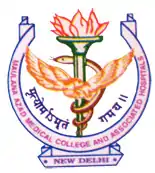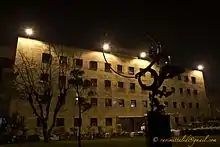Maulana Azad Medical College
Maulana Azad Medical College (MAMC) is a medical college in New Delhi, India affiliated to University of Delhi and run by the Delhi government. It is named after Indian freedom fighter and first education minister of independent India Maulana Abul Kalam Azad. It was established in 1959 at Bahadur Shah Zafar Marg near Delhi Gate.
 | |
Motto in English | Immortality of Mortals by Cure |
|---|---|
| Established | 1956 |
| Affiliation | University of Delhi |
| Dean | Dr Nandini Sharma[1] |
Academic staff | 426[2] |
| Undergraduates | 250+40[2] |
| Postgraduates | 245[2] |
| Location | |
| Campus | Urban |
| Website | mamc |
Four hospitals attached to MAMC have a combined bed strength of 2800 beds[2] and cater to millions in Delhi alone and many more from the surrounding states in north India. The college is a tertiary care referral centre and has teaching programs for graduate and postgraduate degrees and residency and subspecialities/fellowships (referred to as superspecialities in India).
History

The history of Maulana Azad Medical College can be traced to 1936, when India was under British rule. During that time, Indian Medical Service was being heavily manned by the British. In 1940, Martin Melvin Curickshank of the Indian Medical Service (IMS) was appointed Medical Superintendent of Irwin Hospital and Chief Medical Officer of New Delhi. He was appointed specifically to establish a medical college complex near Ramlila Maidan.[3] But before his plans could come to fruition, the Second World War started in 1939 and the plan of a new medical college had to be dropped.
During the Second World War, some barracks were rapidly constructed near Safdarjung's tomb to establish a medical centre for American troops fighting in this region. That hospital was well equipped, with x-ray machine, a laboratory, and other facilities for various emergency procedures. After the Second World War was over, America handed over the hospital to Indian government and it is now known as Safdarjung Hospital. Later a medical college was started there by Central Government Health Scheme of the Health Ministry.
MAMC made a very humble beginning in 1958 at the erstwhile Irwin hospital (now the Lok Nayak Hospital). The foundation stone for the new buildings of the college was laid in October 1959 by Govind Ballabh Pant at the 30 acre land of the old Central Jail which was not in use.
Courses offered
Four hospitals – Lok Nayak Jay Prakash Hospital, GB Pant Institute of Postgraduate Medical Education & Research, Maulana Azad Institute of Dental Sciences and Guru Nanak Eye Centre – are situated in the college campus and attached to the college. These make available 2800 beds, 7200 daily outpatient attendance and 47 operation theatres for the patients and for the medical students to learn. It caters to 290 undergraduate students, 245 post graduate and post doctoral students per year being trained by 426 faculty members and 810 resident doctors.
The medical college offers MBBS and MD and MS degrees and postgraduate residency courses for super-speciality / sub-specialty fellowship degrees of MCh and DM. Institutes offering degrees in nursing and pharmacy are also attached to the college. There are more than 30 courses being offered in MAMC in the Medical Stream. Govind Ballabh Pant Institute of Postgraduate Medical Education and Research, a sister institute, located within the camps provides courses in super specialties and basic subjects.[4] Post Doctoral courses in Pediatric surgery and Neonatology are available at MAMC. Post Doctoral courses in other specialties like GI Surgery, Cardiology etc are available at GB Pant Hospital.
Ranking
| University and college rankings | |
|---|---|
| Medical – India | |
| NIRF (2020)[5] | 17 |
| Outlook India (2019)[6] | 11 |
| The Week (2019)[7] | 5 |
| India Today (2019)[8] | 4 |
MAMC Delhi was ranked 17th among medical colleges in India by the National Institutional Ranking Framework in 2020.[5] MAMC was ranked fourth among medical colleges in India in 2019 by India Today[8] and 5 by The Week[7] and 11 by Outlook India.[6]
Notable people
- Amit Banerjee, cardiothoracic-vascular surgeon, Dr. B. C. Roy Award, formerly head of CTVS, GBPH; first alumnus to serve as MS. Lok Nayak Hospital, former VC, West Bengal University of Health Sciences; current VC, SOA University, Bhubaneswar.
- Prem Chandra Dhanda, former principal and Padma Bhushan awardee
- Ravinder Goswami, Shanti Swarup Bhatnagar laureate
- Upendra Kaul, an interventional cardiologist and the winner of a Dr. B. C. Roy Award and Padma Shri[9]
- Kamal Kumar Sethi, former professor and Padma Shri recipient
- Anil Aggrawal, forensic pathologist, editor of Anil Aggrawal's Internet Journal of Forensic Medicine and Toxicology.
Notable alumni
- Brijendra Kumar Rao, Padma Bhushan in 2009, former chairman of Sir Ganga Ram Hospital, New Delhi and member of Medical Council of India
- Saumitra Rawat, head of surgical gastroenterology and liver transplants at Sir Ganga Ram Hospital, Padma Shri awardee[10]
Notable faculty
- S. I. Padmavati, former Director MAMC, Padma Vibhushan.
- Dr. Sanjay Tyagi, Dr. B. C. Roy Award winner
Medical Director GB Pant Institute of Postgraduate Medical Education & Research, 2014-2018.Dean,Maulana Azad Medical College, 2018-2019. Director General Health Services, Govt. Of India,2019.
Heritage sites
The college was established at the 30 acre land of the old Central Jail which was no longer in use after the establishment of Tihar Jail at far away Tihar village on the fringe of Delhi. The old Central Jail main building is still within the premises of the college and is listed as a heritage site. The grave of the Mughal era poet Momin lies near the parking area near the college.[11] The infamous Khooni Darwaza where Bahadur Shah Zafar's two sons and a grandson were shot by the British in September 1857 during the First war of independence is opposite the main entrance of the college.
References
- "Dean's Message". mamc.ac.in. Archived from the original on 29 August 2017. Retrieved 10 September 2017.
- "Overview". www.mamc.ac.in. Maulana Azad Medical College. Archived from the original on 19 November 2017. Retrieved 4 November 2017.
- "Obituary Notices". Br Med J. 2 (5416): 1078–1080. 1964. doi:10.1136/bmj.2.5416.1078. PMC 1816948.
- "Courses in GB Pant Hospital". GB Pant Hospital, New Delhi.
- "National Institutional Ranking Framework 2020 (Medical)". National Institutional Ranking Framework. Ministry of Education. 11 June 2020.
- "Outlook Ranking: India's Top 25 Medical Colleges In 2019 Outlook India Magazine". Retrieved 22 January 2020.
- Pushkarna, Vijaya (8 June 2019). "Best colleges: THE WEEK-Hansa Research Survey 2019". The Week.
- "Best Medical Colleges 2019: List of Top Medical Colleges in 2019 in India". www.indiatoday.in. Retrieved 22 January 2020.
- "Dr. Upendra Kaul Credihealth". Credihealth. 2015. Retrieved 13 December 2015.
- "Know about Dr. Saumitra Rawat, selected for this year's Padma Shri". City Air News. 28 January 2015. Retrieved 3 November 2017.
- "In the lanes of Zauq and Ghalib". Indian Express. 15 March 2009. Archived from the original on 21 January 2012.
